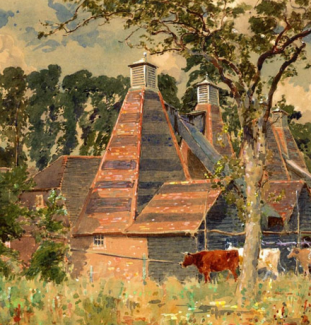
WH Allen's life as a working artist spanned more than fifty years, from the late 1880s to the early 1940s. During that time he painted many thousands of pictures, mainly in watercolour, of the countryside around Farnham and the north Hampshire borders but also in the counties bordering the south coast of England and on the Continent.
William Herbert Allen was born in London in September 1863. His father, William Henry Allen, had moved away from Alton in Hampshire to take charge of a depot at the Great Western Wharf in London, between Greenwich Street and the Thames. The young William Herbert spent his childhood watching the ships, barges and other craft along the river and developed an understanding of rigging and the details of construction that he was to put to good use in his paintings in later years. Proximity to the historic City of London with its surviving fragments of Roman and Norman buildings also inspired an interest in history, archaeology and architecture that was to remain with him for life.
In 1878 the family moved out to Forest Hill, so that “instead of bricks and mortar, railway stations, bridges and the sound of paddle-wheels on the Thames, there were trees and meadows, stately mansions and public parks”. Allen’s parents, however, continued to encourage and support his interest in the arts.
After leaving school, Allen obtained a scholarship at the Royal School of Woodcarving in 1880. Following a period spent in a successful carving workshop, and a brief period as a solicitor’s clerk he returned to education and entered the Royal College of Art in 1884. There he came under the influence of its Director, Thomas Armstrong, a disciple of William Morris and the Arts and Crafts movement. This was to have a profound effect on Allen's artistic development, and remained the predominant stylistic influence throughout his long working life. He also won many prizes, including, in 1888, a silver medal and a travelling scholarship of £50 which enabled him to take the first of many trips to the Continent.
Allen returned from Milan in May 1889, and later the same year was appointed as Art Master at Farnham School of Art. He was later promoted to the post of Director in recognition of his talents, and also put in overall charge of the teaching of art in the local primary and secondary schools.
Although he was to remain at Farnham for the next 39 years Allen was able not only to pursue his private interests but to undertake artistic commissions for the Victoria and Albert and other museums. These tasks took him to France or Italy each year between 1890 and 1909 in order to survey and illustrate historic buildings for publication at home. In 1904 he was elected to the Royal Society of British Artists.
Allen’s personal integrity was reflected in his paintings. To him all landscapes were special. He concentrated on 'ordinary' countryside scenes, often returning to the same spot to capture the changes in light and character through the seasons. His favourite spots included Farnham Park and water meadows, Tilford Bridge, Waverley Woods, Moor Park and Mill, Binsted and the Bourne Valley. However he maintained his links with Alton, where his grandparents had lived and his parents were married, and in 1926 became a founder member of the Alton Art Society, contributing regularly to its annual exhibition.
Allen and his wife spent the last decade of his life not at Farnham but at Wylye in Wiltshire in a house they had noticed on their regular visits to Bradford-on-Avon. Stables were converted into a studio where Allen continued to paint until his death.
A substantial number of his works were bequeathed to the Curtis Museum in Alton which later became one of the founding museums for the County Museums Service. The Allen Gallery was named in recognition of this bequest, and regular exhibitions of Allen’s works continue to be held there.


